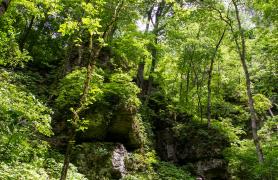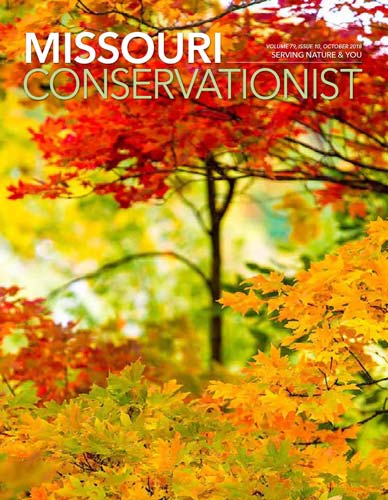What Is it?
Can you guess this month’s natural wonder?

News and updates from MDC
Discover Nature at Poosey Fall Driving Tour Oct. 21
See the natural wonders of a Missouri fall day.
Take a fall staycation and discover nature at the 32nd annual Poosey Conservation Area Fall Tour, northwest of Chillicothe in Livingston County, on Oct. 21, Sunday, from noon–4 p.m.
The driving tour follows roads not normally open to the public through rugged hills and a historical site once known as the Poosey community. Talk with staff at education stations along the way about forest and grassland management, wildlife habitat, and tips for improving fishing in ponds and lakes.
You can also fish, kayak, hike, watch birds and other wildlife, or even scout hunting sites.
The driving tour begins at Pike’s Lake off Route W and County Road 502. Gates open at noon, and the last vehicle will be allowed in at 4 p.m. Gravel roads are graded, but the route involves steep slopes and crossings in low areas. High-clearance vehicles are recommended.
For more information, contact MDC Resource Forester Samantha Anderson at 660-646-6122 or visit short.mdc.mo.gov/ZSS.
Share the Harvest This Hunting Season
If you’ve got permits to take more deer than you can use this hunting season, consider donating your extra venison to Missouri’s Share the Harvest program. Last deer season, thousands of Missouri deer hunters donated 289,292 pounds of venison, including nearly 5,600 whole deer. Since MDC and the Conservation Federation of Missouri (CFM) started the program in 1992, Share the Harvest has provided nearly 4 million pounds of lean, healthy venison to help feed hungry Missourians.
How it Works
Deer hunters donate their extra venison — from several pounds to a whole deer — to participating meat processors throughout the state who grind and package the deer meat. The packaged venison is then given to local food banks and food pantries for distribution to Missourians in need of food assistance. To get Share the Harvest venison, contact local food banks or food pantries.
Processing fees are covered entirely or in part by numerous local sponsors, along with statewide sponsors, including MDC, CFM, Shelter Insurance, Bass Pro Shops, Missouri Chapter Whitetails Unlimited, Missouri Chapter Safari Club International, Missouri Chapter National Wild Turkey Federation, Drury Hotels, Midway USA Inc., Missouri Deer Hunters Association, and Missouri Food Banks Association. For more information, visit short.mdc.mo.gov/Zoz, see the 2018 Fall Deer & Turkey Hunting Regulations and Information booklet, or call 573-751-4115.
What if My Deer Comes From a CWD-Positive County?
Deer taken in counties where CWD has been detected can be donated only through processors participating in the Share the Harvest CWD Testing Program and located in or near any of the 11 CWD-positive counties. You can have your deer sampled for CWD before donating them. Just present the CWD barcode number provided at the sampling location to the participating processor as proof of sampling. You may also present your unsampled deer for donation to approved processors in or near any of the 11 counties, and the processor will collect a tissue sample or the head for testing.
Those 11 counties include: Adair, Cedar, Cole, Franklin, Jefferson, Linn, Macon, Perry, Polk, St. Clair, and Ste. Genevieve. For more information on donating a deer in a CWD positive county, visit mdc.mo.gov/CWD.
Ask MDC
Got a Question for Ask MDC? Send it to AskMDC@mdc.mo.gov or call 573-522-4115, ext. 3848.
Q. Are air bows legal to hunt deer in Missouri?
A: Yes, but they are not considered archery equipment. They are defined as a firearm by the Wildlife Code of Missouri because the device propels a single projectile at one discharge. Even though they are smaller than 0.40 caliber — the minimum requirement for an air-powered gun — they are legal for firearms and alternative methods deer hunting.
Q. I recently noticed these webs all over the yard, especially after a foggy morning. What creature creates this work of art?
A: Sparkling with morning dew, the unique web of the funnel weaver spider is often more noticeable than the spider itself.
Typically, these webs are horizontal sheets with funnels leading down to a shelter, such as a rock crevice or denser vegetation. The sheet can be up to 3 feet wide and the funnel can be more than 1 foot long, although they are often smaller than that.
Often, these spiders can be seen crouched in the funnel’s center as they wait to capture their unfortunate prey. Beetles, moths, small butterflies, and daddy longlegs are frequent food items.
Sometimes funnel weaver webs are found attached to houses, especially in corners near a porch light. Funnel weaver spiders are harmless to humans and provide truly organic insect control.
Q: I found these ringed salamanders at Rockwoods Reservation. I see them listed as a species of conservation concern. Is this still true?
A: Ringed salamanders are considered vulnerable in Missouri, due to their relatively low numbers, restricted range, and the threat of collection for the pet trade. Found mostly in the southwestern and central Missouri Ozarks, this salamander’s range also extends into the Ouachita Mountains and Ozark Highlands of Arkansas and Oklahoma.
“They have a limited distribution in North America,” said Missouri State Herpetologist Jeff Briggler. “Close to 60 percent of this species’ entire range occurs in Missouri, which means we have a special responsibility to ensure their survival.”
He noted they can be quite abundant in some locations, but sparse in others, even when habitat appears to be acceptable. They usually hide under logs and rocks or in burrows made by small mammals, seldom venturing into the open and preferring heavily wooded areas. As temperatures cool in autumn and rain is more common, they travel by night to fishless woodland ponds, where they may congregate by the hundreds for breeding.
“People don’t see them because they are mostly active on rainy nights,” Briggler added.
What Is It?

Black Vulture
With their large black bodies and naked black heads, black vultures (Coragyps atratus) are easy to spot on the side of the road, feasting on roadkill. These birds can live for 25 years and prefer to stay in tight-knit family groups. They are found statewide, but most often in the extreme southern parts of the state. Black vultures are listed as a species of conservation concern and are protected by the Migratory Bird Treaty Act.
Agent Advice from Brian Shelton, Pemiscot County Conservation Agent
If the cool, crisp autumn mornings are making you eager to get out in the woods in search of a flock of turkeys, you’re not alone. Before you head out to pursue the state’s most popular game bird, make sure you’re prepared. Fall turkey season includes two methods — firearms and archery — and each requires a separate permit. Purchase the permit you need at mdc.mo.gov/permits. With hunters afield using two different methods, safety is key. Wear blaze orange and stay visible when moving about. Always positively identify your target and what’s just beyond it before shooting. You can legally harvest two birds, male or female, on the same day. Now, grab your call and get out there!
Invasive Species: Bush Honeysuckle
Invasive nonnative plants consume wildlife habitat and pasturelands and compete with crops. Do what you can to control invasive species when you landscape, farm, hunt, fish, camp, or explore nature.
What Is It?
Introduced in the mid to late 1800s for landscape ornamentals, wildlife food and cover, and erosion control, bush honeysuckles are native to eastern Asia. Depending on the variety, bush honeysuckle can grow from 6 to 20 feet tall. Leaves are green with a pale green, fuzzy underside. Twigs of all bush honeysuckles are thornless and hollow. In the spring, fragrant white or pink flowers appear, but become yellowish as they age. The shrub’s red berries mature in pairs near the origin of the leaves in September to October. Each berry contains seeds that are distributed by foraging birds and small mammals.
Where Is It?
Morrow’s and Amur are the two species of bush honeysuckles that are the most invasive in Missouri. You can find them statewide, with especially high densities in urban areas. They can survive in shaded forest understory, and some varieties can tolerate wet soils and moisture, including bogs, fens, lakeshores, and riparian areas. Thriving on neglect, they are also found along fencerows, thickets, woodlands, roadsides, pastures, old fields, and unattended areas.
Why It’s Bad
“Bush honeysuckles are born competitors, and native species pay the price,” said Nate Muenks, habitat management coordinator. “Leaves appear early in the spring and remain late into fall, giving them an advantage over native plants. They form a thick understory that limits sunlight to native plants, inhibiting seedling establishment and forest regeneration. They also compete for soil moisture, nutrients, and may produce a chemical that inhibits native plant growth. Bush honeysuckle competes with native plants for pollinators, which could result in fewer seeds set on native species. Bush honeysuckles produce numerous berries, but unlike native shrubs, the fruits of nonnative bush honeysuckles are carbohydrate-rich and do not provide migrating birds with the high-fat content needed for long flights.”
How to Control It
October and November are excellent months to identify and remove bush honeysuckle because most natives are dormant. When the plant is small and the soil is moist, hand pulling is an option if the entire plant can be removed. The cut-stump method involves cutting the bush off at the stump and applying a herbicide solution to thoroughly cover the freshly cut area. Spray the leaves in early spring or late fall with a herbicide solution before or after the leaves of native plants are present. The basal-bark method consists of spraying a herbicide mixture to the bush’s stems to a height of 12 to 15 inches from the ground. As always, read and follow the label instructions carefully when using herbicides. Finally, fire assists in the control of honeysuckle if there is enough fuel and the area can be burned safely. Burn every spring or every other spring for several years to control resprouting.
- Bush honeysuckles are one of the first plants to leaf out in the spring and one of the last to drop their leaves in the fall, giving them the upper hand over native species.
- If controlling bush honeysuckle with the cut-stump method, be sure to treat the stump with a recommended herbicide immediately after cutting it or the stump will resprout vigorously.
Alternative Native Plants
- deciduous holly
- crabapple
- plums
- shrub dogwoods
- downy serviceberry
For more information, visit short.mdc.mo.gov/ZcX
Springfield Nature Center Celebrates 30 Years
Since it opened in 1988, Springfield Conservation Nature Center has welcomed almost 2.8 million visitors, and more than 6 million have discovered nature through a variety of natural habitats on the nearly 3 miles of trails. The nature center will mark this 30-year milestone with special events during the first weekend in October: Friday, Oct. 5: Join us for an open house from 5–9 p.m. Musician and primitive skills specialist Bo Brown will weave together a program featuring music, stories, images, and musings about birds, nature, and other outdoor pursuits from 7–9 p.m. during Nature and the Arts: Songs and Birds.
Saturday, Oct. 6: Enjoy naturalist-guided hikes at 9 a.m. and 1 p.m. Have an
interest in photography? Register for Volunteer Naturalist Dan Liles’ Nature Photography
Basics program from 9 a.m.–noon.
Sunday, Oct. 7: Wrap up the weekend at Primitive Skills Day from 1–5 p.m.
with demonstrations on flint knapping, bow-and-arrow construction, fire making,
and cordage wrapping using plant fibers and beadwork.
The Springfield Nature Center is at 4601 S. Nature Center Way. Call 417-888-
4237 for more information.
Agents go Live on Facebook
Join us for Ask an Agent on Facebook Live Oct. 31 from noon to 12:30 p.m. Conservation agents will answer questions about a variety of topics, including hunting, fishing, trapping, and other regulations.
Visit facebook.com/moconservation at the time of the session. Post your questions in the comments section.
Got an Evergreen? It Could be the Governor’s Next Christmas Tree
The annual search is underway for a large evergreen to adorn the governor’s mansion lawn in Jefferson City for the Christmas season. The donated tree must be about 40 feet tall and either an eastern red cedar, Norway spruce, or white pine that is fully branched on all four sides and accessible by large equipment.
The right tree may be near the end of its life, or it may need to be removed for other reasons. Once a tree is selected, MDC staff will coordinate cutting and delivery to the governor’s mansion at no cost. The donor will receive a thank-you from the governor and an invitation to the lighting ceremony, which usually occurs the first week of December.
Take photos of candidate trees and email them with contact information to holidaytrees@mdc.mo.gov. Be sure to include a telephone number, location of the tree, and several pictures taken from different angles and distances. Nominations can also be submitted by mail to: Missouri Department of Conservation, ATTN: Mansion Christmas Tree, PO Box 180, Jefferson City, MO 65102. All entries must be submitted by Oct. 10.
Discover Nature: Wild Turkey Muffaletta Sandwiches
The resurgence of the wild turkey in Missouri during the past 45 years has rekindled interest in this splendid bird. Today, Missouri turkey hunters can pursue turkeys for three weeks in the spring and one month during the fall and archers can add almost another three months during the fall archery season. To learn more about turkey hunting in Missouri visit huntfish.mdc.mo.gov/ hunting-trapping/species/turkey.
Relish
- ¾ cup chopped red onion
- ½ cup chopped sweet red pepper
- 1 stalk celery, chopped
- ½ cup kalamata olives, pitted
- ½ cup drained small Spanish pimiento-stuffed green olives
- ¼ cup extra-virgin olive oil
- 2 tablespoons drained capers
- 2 tablespoons chopped parsley
- 12 fresh basil leaves, roughly sliced
- 1 teaspoon chopped fresh oregano
- 1 teaspoon chopped fresh chives
- 1 tablespoon red wine vinegar
- Freshly ground black pepper
Sandwich
- 1 24-inch-long French or sourdough baguette, split lengthwise
- 12 ounces cooked wild turkey breast, sliced
- 4 ounces Jarlsberg or good Swiss cheese, sliced
- Tomato slices (optional)
Combine relish ingredients in food processor and chop finely. Add pepper to taste. Transfer to bowl. Let stand 1 hour at room temperature.
Spread half of muffuletta relish over each cut side of bread. Place turkey and cheese on bottom half of bread. Top with tomato slices. Cover with top half of bread. Cut diagonally into
4 sandwiches.
Serves 4
Find more wild recipes in Cooking Wild in Missouri. Order yours at mdcnatureshop.com.
Share the Harvest
Donated deer meat goes to local food banks and food pantries to help feed hungry Missourians. Thousands of Missouri deer hunters donated 289,292 pounds of venison to the state’s Share the Harvest program in 2017. Since 1992, Share the Harvest has provided nearly 4 million pounds of lean, healthy venison. For more information visit short.mdc.mo.gov/Zoz
Also In This Issue


This Issue's Staff
Associate Editor - Bonnie Chasteen
Staff Writer - Larry Archer
Staff Writer - Heather Feeler
Staff Writer - Kristie Hilgedick
Staff Writer - Joe Jerek
Creative Director - Stephanie Thurber
Art Director - Cliff White
Designer - Les Fortenberry
Designer - Marci Porter
Photographer - Noppadol Paothong
Photographer - David Stonner
Circulation - Laura Scheuler






















